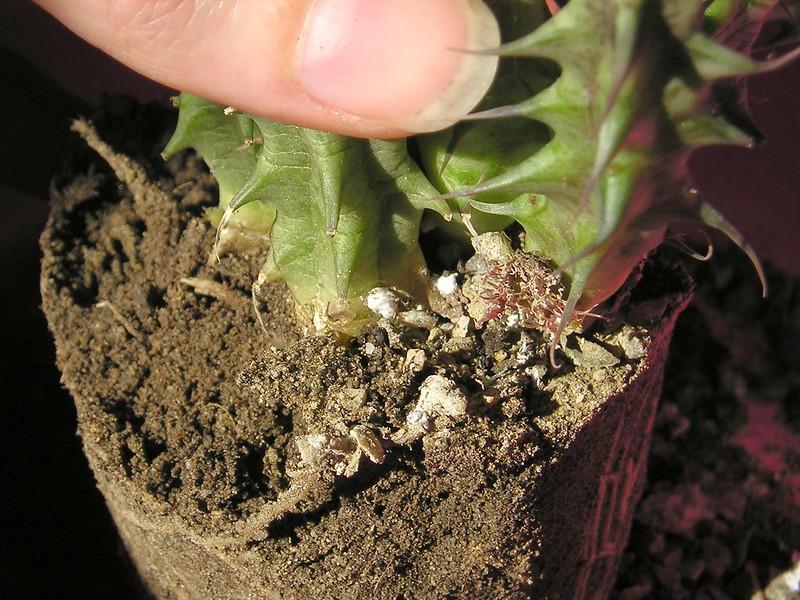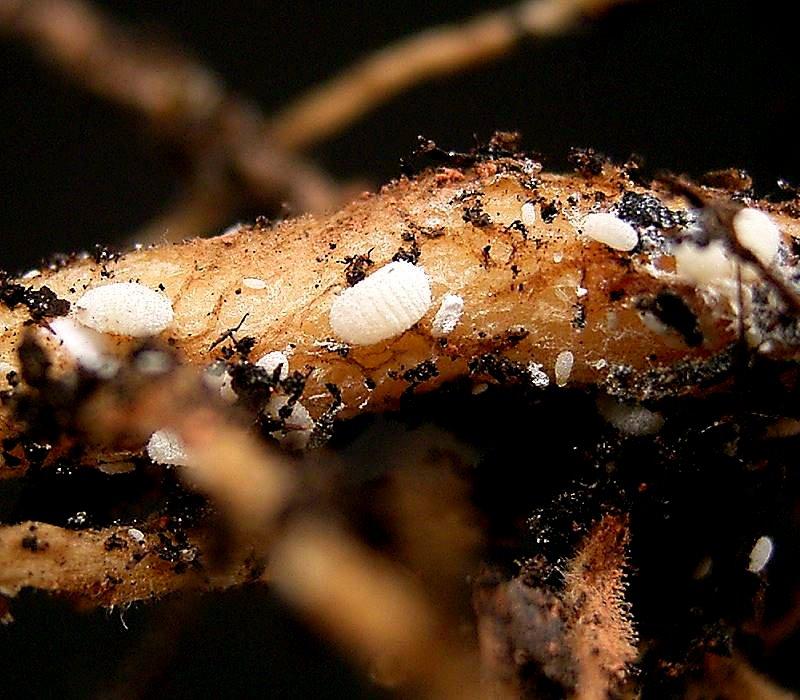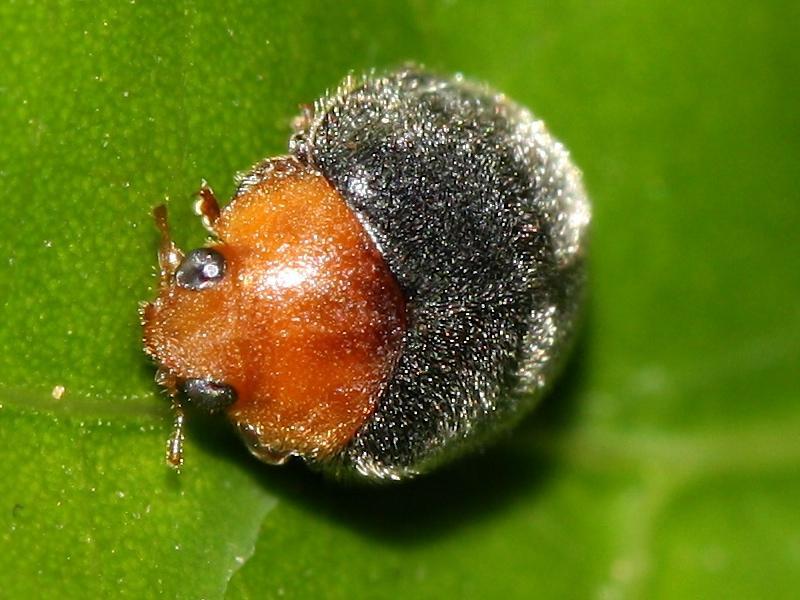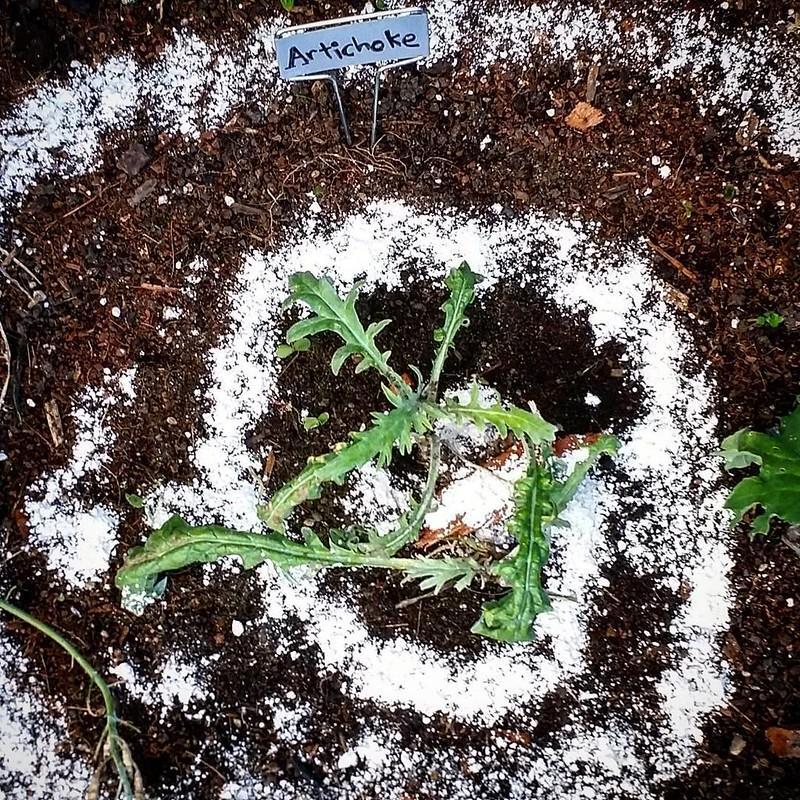The word “mealybugs” refers to hundreds of different species of insects, of which approximately 300 can be found in North America. They cause damage to the host plants by sucking the juice, especially from young growth, which they prefer. In this article, we will focus on a particular kind of mealybugs, the root mealybugs, which attack plant roots and render them incapable of absorbing water and other essential nutrients. in this article, let’s take a closer look at mealybugs in soil and how to get rid of them.

The sole visible symptom of root mealybug activity is the loss in plant health and vigor.
Mealybugs found in the soil can cause significant damage to a plant and even spread to other perfectly healthy plants in your home or garden. Getting rid of root mealybugs that have invaded indoor and outdoor plants can be pretty challenging, but it is not impossible!
Applying isopropyl alcohol, soaking plants in hot water, releasing a special kind of beetle that feeds on mealybugs, and adding diatomaceous earth to the soil of your plants are all effective strategies for controlling mealybugs in the ground.
However, if these treatments do not work, it is best to dispose of the plant to prevent the infection from spreading to other plants.
Keep reading to learn more!
Root Mealybugs: What Are They?

Root mealybugs are mealybugs that live beneath the ground and feed on plant roots.
There are hundreds of different species of mealybugs, but the root mealybug is the most destructive. This is because it lives deep in the roots of plants and cannot be seen openly.
When you first become aware of what is going on, the infestation may have already progressed to a more advanced stage. Therefore, use caution when dealing with this cunning bug.
Related: How to Kill Mealybugs on Plants With Organic and Inorganic Methods?
Root Mealybugs: Habitat & Identification
These pests favor hot and humid conditions; therefore, greenhouses can be an ideal location for them to infest. Mealybugs that plague roots can cause severe damage to the host plant. If you dig around the base of the plant just a little bit, you can locate the infected roots.
Root mealybugs are very similar to their above-ground cousins. However, they are much smaller, measuring between one-twentieth and one-fifth of an inch.
Their pink bodies are covered in this whitish cotton fluff, and their sticky, cottony tendrils are white and cottony, giving them a fuzzy appearance. Depending on who you ask, this species is referred to as either Rhizoecus dianthi or Rhizoecus americanus.
They are also known as soil mealybugs or blind mealybugs. And, know that when root mealybugs declare a plant their territory, they can inflict severe damage, even the death of the plant. So, whatever name you pick, get rid of them as soon as possible.
Signs Of A Root Mealybug Infestation
It is absolutely necessary to detect an infestation of root mealybugs in its early stages. However, there is an issue with this! It is always going to be a little bit tough to determine whether or not the roots of your plant are infested with root mealybug.
Very few signs point to an infestation above the soil line. However, when the situation has gotten out of hand, you will be able to see these bugs at the base of the stem.
In some instances, you might also notice that ants are climbing the infected plants. However, it would help if you never held off until you reached this point.
There are a few techniques to spot an infestation in its early stages. So, if you are watchful and continue to inspect your plants on a regular basis, you will be able to recognize a plant that has been infected with root mealybugs before it is too late.
- If you ever notice a bluish tint to the soil in your containers or the soil in your garden, it may be caused by the white fluffy secretions that root mealybugs leave behind.
- If there is no sign evident in the soil, but your plant has mold on it or is changing color and turning yellow, you should investigate the compost to see if there are any mealybugs in the roots of the plant.
- Regularly do a little digging around the base of the plant to check for soil mealybugs. Checking the roots on a regular basis is a healthy practice that should be maintained even if you do not see any of the symptoms listed above.
Related: What Are Mealybugs? How to Kill Them on Succulent Plants?
How To Get Rid Of A Root Mealybug Infestation?
As was just mentioned, identifying and treating a root mealybug infestation in your plant as soon as possible is of the utmost importance if you hope to save your plants from death. Treatment of root mealybugs is far more difficult than the treatment of mealybugs found above ground.
Even pesticides are not always effective against soil mealybugs because they are wrapped in a waxy fluff. Sometimes the only way to rescue the remainder of the garden is to throw away the plant that is affected by the soil mealybugs.
If, on the other hand, the infestation is not particularly serious, we recommend the following organic and natural treatment options. If, however, the roots are heavily infested, insecticides must be applied in a systematic manner.
How To Get Rid Of Root Mealybugs Naturally?

A mealybug ladybird. This insect can be used to control mealybug populations in a garden.
We always recommend using organic and natural control methods to get rid of a root mealybug infestation. It is because they are safe, both for you and your plants.
Pro Tip: If you want the best outcomes, it is usually a good idea to employ multiple approaches in combination, rather than relying on just one method to get the job done.
Keeping this information in mind, give the following recommendations a go in order to get rid of root mealybugs once and for all.
Isolate The Infected Plants
Isolating the infected plants as soon as possible is the first step, whether it is a mild infestation or a full-fledged attack by root mealybugs. This is especially important if the infected plants share a watering container with other plants in good condition.
Root mealybugs typically cannot travel significant distances under the soil to attack other plants. Also, they are content to remain on a single plant until it is entirely killed.
However, there is still a significant risk that they will attack the neighboring plants if they are kept in the same container.
Related: An All-In-One Guide to Small Brown Bugs | Fun Facts, Pictures and Identification Guide
Soak The Roots Of Infested Plant With Hot Water
Another option that is both risk-free and effective in getting rid of a mealybug infestation is to soak the plant’s roots in hot water. To accomplish this, remove the plant from its container, remove as much soil as possible, and then submerge the roots in approximately 120 degrees Fahrenheit water for approximately ten minutes.
Be sure to clean the container before putting the plant back. You can also wash the pot with dish soap, which will kill any eggs or larvae that might still be within.
You can easily irrigate the soil with hot water if the plant is large and its roots cannot be cleaned. Furthermore, take care not to overwater the plants. You should continue repeating this treatment once every two days until the mealybugs are no longer a problem.
Wash The Area With Soap Water
Using a solution of soap and water is yet another simple method that can be utilized to eradicate soil mealybugs. You can make this solution by combining around 3 liters of water with two tablespoons of dish soap into a bucket of water.
The insecticidal soap mixture should be used to rinse both your plant and the soil surrounding it. Root mealybugs will no longer be able to feed on your plant as a result of this, and they won’t want to live in the region.
Use Rubbing Alcohol To Kill Soil Mealybugs
Isopropyl alcohol, also known as rubbing alcohol, is a powerful disinfectant. This can also be used to get rid of soil mealybugs. To do this, use a cotton swab and dip it in rubbing alcohol or use a gentle spray of rubbing alcohol directly on the root mealybugs.
However, you must exercise extreme caution. Rubbing alcohol has the ability to eradicate root mealybugs quickly, but it poses a risk to your plant if it is applied in excessive amounts or not handled with care. Therefore, use caution and aim your efforts directly at the mealybugs, avoiding the plant’s roots in the process.
Controlling Mealybugs With Mealybug Destroyers
Mealybug ladybirds, also known as mealybug destroyers, can also be used to control mealybugs in a garden. Each of these insects can consume more than 250 juvenile mealybugs or more than 1,000 eggs. You can introduce these insects into the affected soil, and they will begin devouring the root mealybugs and the eggs they lay.
Using Chemicals To Control Mealybugs

Use of Diatomaceous Earth to keep insect pests away from garden plants.
In some cases, when an infestation gets totally out of hand, natural or organic control methods to control soil mealybugs will not work because of their gentle nature.
In such situations, you will have to turn to chemical control methods, which include using chemical insecticides to get rid of these nasty pests from your plants.
Acephate & Malathion
An effective treatment for soil mealybugs is to apply a spray containing either acephate or malathion to the soil. You can make a malathion spray by combining one teaspoon of Malathion-50 with four liters of room temperature water and stirring the mixture.
You can now spray the ground with this concoction. To achieve the desired results, you will need to repeat this process multiple times over the course of several days.
Diatomaceous Earth
Another alternative approach that has been effective in getting rid of mealybugs is using Diatomaceous Earth. Technically speaking, diatomaceous earth is not a pesticide. Diatomaceous Earth is created from the skeletal remains of microscopic algae.
It contains very sharp particles that puncture the bodies of soil mealybugs and other insects. Diatomaceous Earth can eliminate root mealybugs without endangering the plant.
Preventing Soil/Root Mealybug Infestations
Since soil mealybugs can be very challenging to eradicate, the most effective method for managing these pests is to take measures to avoid infestations in the first place. Root mealybugs, fortunately, are sluggish crawlers, and female adults of the species cannot fly.
As a result, these insects are transported into the garden either on newly bought plants, garden tools, or in containers that have been used previously. Here are a few ways you can reduce your chances of getting a root mealybug infestation:
- Ants are known to carry mealybugs from one plant to another. So, limiting ant populations will also assist in reducing the number of mealybugs present.
- You should also avoid applying fertilizers that contain nitrogen to plants that are known to be harboring mealybugs. This is due to the fact that nitrogen has been shown to stimulate the production of mealybug eggs.
- Lastly, to prevent mealybugs from infesting your garden plants, you must properly inspect any new plants you purchase and clean all your gardening tools and containers.
Frequently Asked Questions
How do you get rid of mealybugs in soil?
Soaking the roots of an infected plant in hot water is a safe and effective approach to getting rid of a mealybug infestation in the soil. Chemical pesticides can also be used in cases of severe infestations. While several plant insecticides may kill mealybugs, I’ve found that 70% isopropyl alcohol is the most effective.
How do you kill mealybugs in the roots?
Root mealybugs can be eradicated with a hundred percent success by immersing potted plants in water heated to 120 degrees Fahrenheit (49 degrees Celsius) until the temperature of the internal root ball reaches 115 degrees Fahrenheit (46 degrees Celsius). This treatment has little to no effect on the potted plants.
Will baking soil kill mealybugs?
Baking will kill any bugs that may be hiding in the soil, preventing an infestation in the future. One of the excellent home remedies for eliminating Mealybugs is the use of dusting baking soda. In addition to baking soda, salt can also be used to get rid of root mealybugs. They can be killed by sprinkling salt directly on them.
How did my plant get mealybugs?
While mealybugs may seem to arrive out of nowhere, they are frequently transported into your house. They might, for instance, enter your home (or outside plants) if you bring infested plants from a nursery. Mealybugs are drawn to plants with high nitrogen levels and soft growth. So, they will attack the plants if your plants are overwatered and over-fertilized.
How long can mealybugs live in soil?
It has been demonstrated that some mealybugs can live for longer than two weeks away from their host plants, and their eggs can continue hatching for up to 45 days.
Mealybugs may have anywhere from two to six generations per year, depending on the species and the environment in which they live.
Sources For Further Reading
Root Mealybugs / Floriculture and Ornamental Nurseries / Agriculture: Pest Management Guidelines / UC Statewide IPM Program (UC IPM). (2022). Retrieved 22 August 2022, from https://www2.ipm.ucanr.edu/agriculture/floriculture-and-ornamental-nurseries/Root-Mealybugs/#:~:text=Root%20mealybugs%20are%20belowground%20dwelling,of%20their%20foliar%2Dfeeding%20relatives.
Mealybugs, R. (2022). Root Mealybugs | NC State Extension Publications. Retrieved 22 August 2022, from https://content.ces.ncsu.edu/root-mealybugs
Mealybugs in Greenhouses. (2015). Retrieved 22 August 2022, from https://ag.umass.edu/greenhouse-floriculture/fact-sheets/mealybugs-in-greenhouses
Mealybugs Management Guidelines–UC IPM. (2022). Retrieved 22 August 2022, from http://ipm.ucanr.edu/PMG/PESTNOTES/pn74174.html
Editor’s Recommendations
How To Identify Insect Eggs On Leaves And Get Rid Of A Pest Problem?
How To Identify, Control, And Prevent Brown Soft Scale Bugs On Plants?
How To Protect Hostas From Snails & Slugs? The Ultimate Guide







